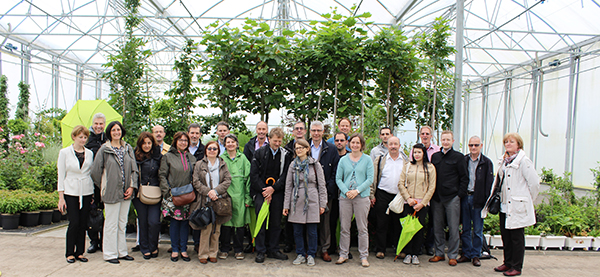
54th meeting of the Working Party on Phytosanitary Regulations
Ghent (BE), 2016-06-14/17
The 54th meeting of the Working Party on Phytosanitary Regulations took place in Ghent, Belgium on 2016-06-14/17 at the kind invitation of the NPPO of Belgium. There were 21 participants from 17 EPPO countries and 1 observers from the European Commission . This EPPO Working Party directs and supervises the technical work of many EPPO Panels related to plant health. A summary of the different Panel meetings and Workshop which took place since the last meeting was presented to the Working Party (short summaries of these meetings are posted on this website). The Working Party also discussed the work programme for 2017 and made several recommendations that will be presented to the EPPO Council.

Participants - View more pictures >
New and revised EPPO recommendations and Standards
The Working Party recommended that 3 new pests should be added to the EPPO Lists of pests recommended for regulation: Lycorma delicatula (A1 List of pests absent from the region), Euwallacea fornicatus sensu lato and Fusarium euwallaceae (A2 List of pests present in the region). Following a revision of the taxonomy of several listed pests, it was agreed to add Xanthomonas fuscans subsp. aurantifolii (in addition to Xanthomonas citri subsp. citri) to the A1 List and to replace Epitrix similaris by Epitrix papa on the A2 List.
10 new Standards were considered ready to be presented for approval at Council:
- Phytosanitary Procedures (series PM3)
- Consignment inspections for Xylella fastidiosa
- Inspection of places of production for Xylella fastidiosa
- Pest Risk Analysis (series PM5)
- Guidelines on the phytosanitary measure ‘plants grown under complete physical isolation' (new)
- Diagnostics (series PM7)
- Xanthomonas axonopodis pv. allii (new)
- Acidovorax citrulli (new)
- DNA barcoding as an identification tool for selected regulated pests (new)*
- Guideline on the authorization of laboratories to perform diagnostic activities for regulated pests (new)*
- National Regulatory Control Systems (series PM9)
- Baccharis halimifolia (new)
- Popillia japonica: Procedures for official control (new)*
- Epitrix species damaging potato tubers (new) - to be presented with the objection of Spain
* in these cases the Working Party gave provisional endorsement, subject to the relevant Panels (Diagnostics and Phytosanitary Measures respectively) having no objections to some final changes to address country comments.
The Working Party also noted the revisions of the following Standards approved since its last meeting according to a specific procedure:
- PM 7/79 Grapevine flavescence dorée phytoplasma
- PM 7/42 Clavibacter michiganensis subsp. michiganensis
- PM 7/60 Pantoea stewartii
- PM 7/41 Meloidogyne chitwoodi and Meloidogyne fallax
- PM 7/103 Meloidogyne enterolobii
- PM 6/3 List of biological control agents widely used in the EPPO region (version November 2015)
- EPPO codes
The Working Party discussed how EPPO codes could be used for ePhyto. It should be investigated how work needed on codes could be funded.
- Information Services
The Working Party discussed how pest reports should be exchanged between EPPO and IPPC. A Specification for an PM3 Standard Raising public awareness to encourage plant pest reporting was agreed.
- Diagnostics
Reports of 5 Panel meetings and 3 workshops were presented. Input of EPPO Panels in the development of IPPC protocols was noted. To support identification of priorities for validation of tests, a survey on the use of tests in EPPO diagnostic protocols will be launched. The revision of the Diagnostic protocol PM 7/24 Xyllela fastidiosa was discussed. It is currently under consultation by Member countries within the fast track procedure (adopted since). The Working Party was also presented the new sequencing technologies for diagnostics (NGS) and the possible consequences for risk management.
- PRA activities
The Working Party was presented with the results of a survey on the use of the different PRA schemes in the EPPO region. It agreed that the Secretariat should investigate a possible platform to exchange information on national PRAs.
The Working Party considered PRA reports on Citrus exocortis viroid, Columnea latent viroid, Pepper chat fruit viroid, Tomato apical stunt viroid, Tomato chlorotic dwarf viroid, and Tomato planta macho viroid and recommended that they should be considered along with PSTVd, within the RNQP project.
The Working Party agreed that a statement should be made at the Council that intercontinental movement of soil with plants for planting is high risk for plant health. It further recommended that the draft ISPM on the Movement of growing media in association with plants for planting in international trade should be analysed by the Panel on Phytosanitary Measures to check whether further work should be done on this subject.
The Working Party agreed that the next Expert Working Groups (EWG) for PRA to be organized should be 'Candidatus Phytoplasma phoenicium' (almond witches' broom). In 2017, EWGs may be organized on Massicus raddei, Grapevine red blotch-associated virus and Thekopsora minima.
Project on Regulated non-Quarantine Pests
The Working Party was presented with the methodology under development to assess RNQPs. The work will be carried out with dedicated working groups.
Specific projects
A document was presented to update the Working Party on the objectives and expected results of the LIFE IAP RISK project. The Working Party was informed that discussions continue on the possibility for EPPO to host the Q-bank database.
International phytosanitary issues
The following issues were discussed:
- Exchange of pest reports between EPPO and IPPC
- ePhytos
- nominations of European experts for IPPC bodies
The next Working Party on Phytosanitary Regulations is due to convene in Poland, on 2017-06-20/22.
